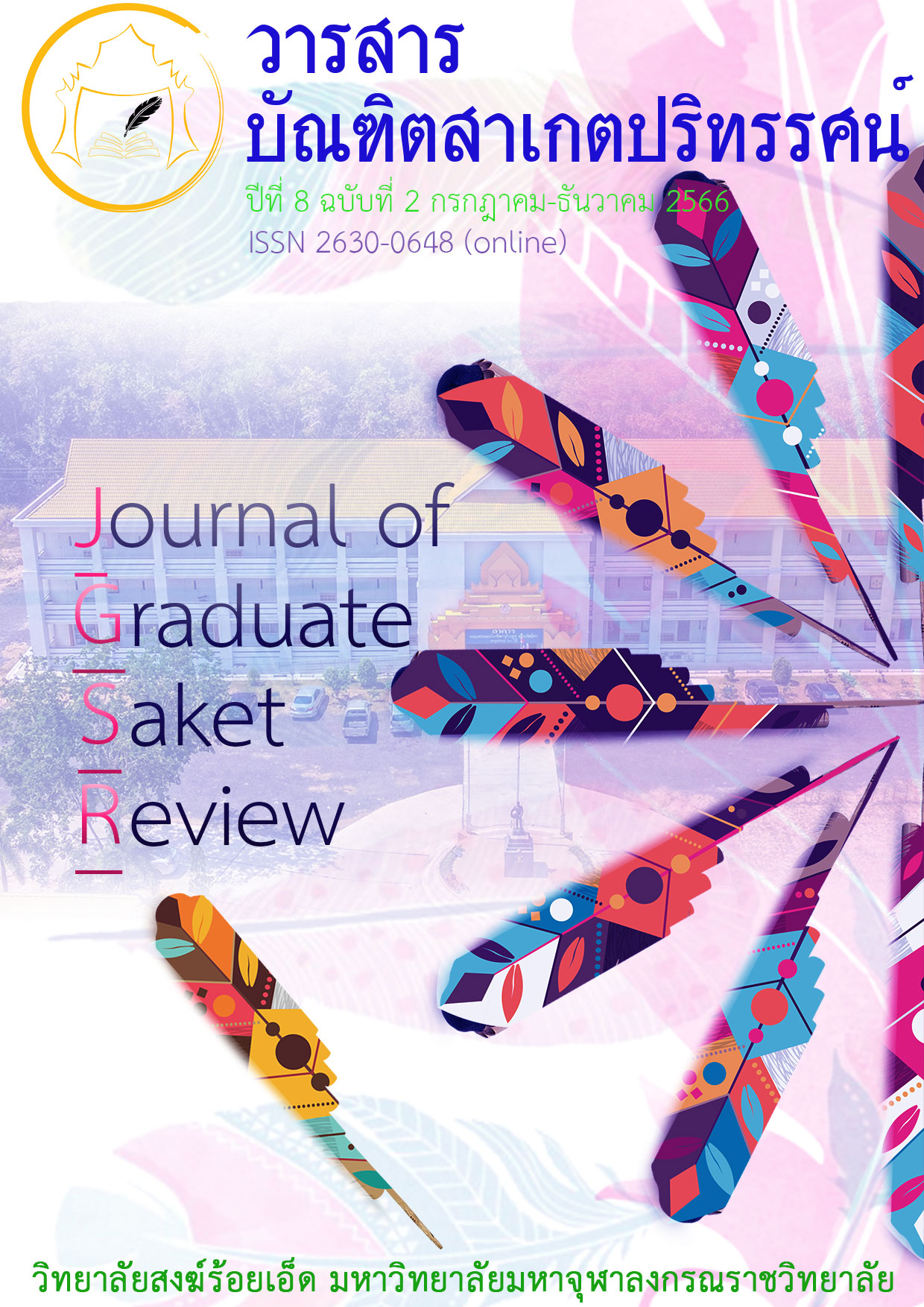The way of life of the Buddhist monk Mueang Roi-Et district in the situation of the Coronavirus 2019 epidemic
Main Article Content
Abstract
This research article has the objective 1) to study the daily lifestyle of monks in Mueang Roi Et District in the situation of the outbreak of coronavirus 2019 and 2) to study the lifestyle guidelines of monks in Mueang Roi Et District in the situation of the outbreak coronavirus 2019 using qualitative research methods. The target groups for the interview included 25 monks living in Mueang Roi Et District by selecting the population purposively. The research tool is an interview form. Data were analyzed and presented descriptively.
The results of research found that:
1) Living according to the monks’ routines, they have adjusted their routines to suit the situations that occur in all 6 situations, including alms, sweeping areas within the temple, confession of an offense, chanting, practicing paccavekkhaṇa (ideas to be constantly reviewed by a monk), and fostering bhāvanā (development). The new religious routine includes wearing a mask at all times, maintaining social distancing, washing hands with alcohol gel, and cleaning the temple areas on a regular basis to ensure that all monks coexist in harmony. So that the monks live together in the same direction as well as encouraging monks to have daily routines that are modern in today’s society.
2) The way of life of monks has been adapted to suit the current situation, which includes the following five aspects: the way of life, following the government measures,
organizing activities on Buddhist festivals, conducting social welfare, and new way of life. This includes wearing a surgical mask or a cloth face mask, organizing activities during Buddhist festivals, and conducting classes online in accordance with Ministry of Public Health guidelines. The temple should also serve as a center for community assistance and welfare, as well as a model for generating food security based on the ‘Bowon’ (villages, temples, schools) principles. All of this helps monks, novices, and the general public become aware of the situation and how to protect themselves from coronavirus 2019.
Article Details

This work is licensed under a Creative Commons Attribution-NonCommercial-NoDerivatives 4.0 International License.
เนื้อหาและข้อมูลในบทความที่ลงตีพิมพ์ในวารสารบัณฑิตสาเกตปริทรรศน์ ถือเป็นข้อคิดเห็นและความรับผิดชอบของผู้เขียนบทความโดยตรงซึ่งกองบรรณาธิการวารสาร ไม่จำเป็นต้องเห็นด้วย หรือร่วมรับผิดชอบใด ๆบทความ ข้อมูล เนื้อหา รูปภาพ ฯลฯ ที่ได้รับการตีพิมพ์ในวารสารบัณฑิตสาเกตปริทรรศน์ ถือเป็นลิขสิทธิ์ของวารสารบัณฑิตสาเกตปริทรรศน์ หากบุคคลหรือหน่วยงานใดต้องการนำทั้งหมดหรือส่วนหนึ่งส่วนใดไปเผยแพร่ต่อหรือเพื่อกระทำการใด ๆ จะต้องได้รับอนุญาตเป็นลายลักอักษรจากวารสารบัณฑิตสาเกตปริทรรศน์ ก่อนเท่านั้น
References
กรมควบคุมโรค กระทรวงสาธารณสุข. (2563). โควิด-19. สืบค้นเมื่อ 22 มีนาคม 2564, จาก https://www. bbc.com/ thai/thailand-52090088.
พระทวีโชค เจตนาสุโภ (อิ่มชื่น). (2564). การส่งเสริมการปฏิบัติกิจวัตรของพระสงฆ์ไทยในยุค 4.0. วารสารมหาจุฬานาครทรรศน์. 8(11), 312-326.
พระเอกลักษณ์ อชิโต และคณะ. (2563). บทบาทพระสงฆ์กับงานสาธารณสงเคราะห์ภายใต้สถานการณ์การแพร่ระบาดของไวรัส Covid 19: กรณีศึกษาบทบาทของหลวงพ่อแดง นนฺทิโย วัดอินทาราม จ.สมุทรสงคราม. วารสาร มจร สังคมศาสตร์ปริทรรศน์. 9(3), 289-304.
พีรพัฒน์ ใจแก้วมา. (2563). การศึกษาพฤติกรรมการดำรงชีวิตแบบปรกติใหม่ของประชาชนชาวไทยระหว่างวิกฤตโควิด-19 ที่ปรากฏในสื่อออนไลน์. วิทยานิพนธ์หลักสูตรปริญญาวิทยาศาสตรบัณฑิต. สาขาภูมิศาสตร:์ มหาวิทยาลัยนเรศวร.
สุนันทา คันธานนท์ และคณะ. (2564). การปรับตัวของชุมชนวิถีใหม่ในสถานการณ์การระบาดของโรคโควิด-19 ในจังหวัดกระบี่. การประชุมวิชาการระดับชาติ. มหาวิทยาลัยราชภัฏภูเก็ต ครั้งที่ 13.
“การบูรณาการงานวิจัย เพื่อพัฒนาชุมชนอย่างยั่งยืน เพื่อพัฒนาชุมชน อย่างยั่งยืน”. สำนักวิจัย. มหาวิทยาลัยราชภัฏภูเก็ต.
มติชนออนไลน์. (ม.ป.ป.). รายงานสถานการณ์ทั่วโลก จำนวนผู้ติดเชื้อ ไวรัสโคโรนาสายพันธุ์ใหม่ 2019. สืบค้นเมื่อ 21 มีนาคม 2564, จาก htt://travel.trueid.net/detail/EpwDxDold 17.
สยมพร ศิรินาวิน. (2563). “โควิด-19” ความรู้ สู่ปัญญา พัฒนาการปฏิบัติ. นนทบุรี: บริษัท โอ.เอส. พริ้นติ้ง เฮ้าส์.
รัฐบาลไทย. (ม.ป.ป.). ประกาศและคำสั่ง. สืบค้นเมื่อ 22 มีนาคม 2564, จาก https://www.thaigov.go.th.
ไทย พีบีเอส. (2563). ชาวพุทธในยุคโควิด-19. สืบค้นเมื่อ 18 มกราคม 2564, จาก https:// thecitizen.plus/node/ 29094.
Department of Disease Control. (2000). Ministry of Public Health. COVID-19. Retrieved March 22, 2021, from https://www.bbc.com/ thai/thailand-52090088.
Government of Thailand. Announcements and orders. Retrieved on March 22, 2021, from https://www.thaigov.go.th.
Jaikaewma P.. (2020). A Study of the New Normal Living Behaviors of Thai People During the COVID-19 Crisis appeared in online media. Thesis for Bachelor of Science degree program Geography. Naresuan University.
Kanthanon S. et al. (2020). Adaptation of a new normal community in the situation of the COVID-19 outbreak. National academic conference. In Phuket Rajabhat University No. 13 “Integrating Research for sustainable community development for community development Sustainable” Research Office. Phuket Rajabhat University.
Matichon Online. Global situation report number of infected people Novel Coronavirus 2019. Retrieved March 21, 2021, from http://travel.trueid.net/detail/EpwDxDold 17.
Phra Taweechok Jetasupho (Immchuen). (2021). Promoting the Routine Practices of Thai Monks in the 4.0 Era. Mahachulanakakornthas Journal. 8(11), 312.
Phra Ekaluck Achito et al. (2000). Role of monks in public welfare work under the epidemic situation of the Covid 19 virus: a case study of the role of Reverend Father Daeng Nonthiyo, Intaram Temple, Samut Songkhram Province. Journal of MCU Social Science Review. 9(3), 289.
Sirinawin S.. (2020). “COVID-19” Knowledge to Wisdom, Improving Practice. Nonthaburi: O.S. Printing House Company.
Thai PBS. (2000). Buddhists in the era of COVID-19. Retrieved on 18 January 2021, from https://thecitizen.plus/node/ 29094.


